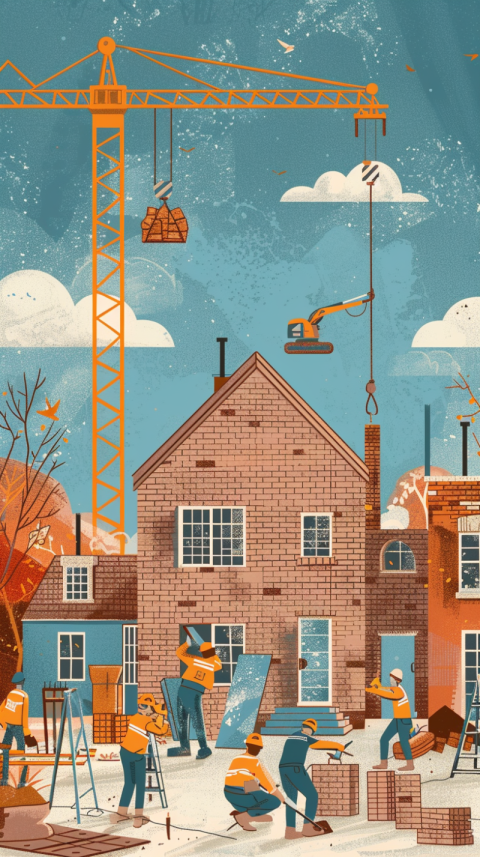











Building the World Around Us - Processes, Materials, and Innovation
The construction industry is a vast and complex sector that encompasses the planning, design, and execution of building and infrastructure projects. It's a fundamental driver of economic growth, responsible for creating the physical environment in which we live, work, and interact. From residential homes to towering skyscrapers, from roads and bridges to dams and power plants, the construction industry shapes our world in profound ways.
1. Types of Construction Projects: A Diverse Range of Structures
Construction projects can be broadly classified into several categories:
- Residential Construction: Building single-family homes, townhouses, apartments, and other types of housing.
- Commercial Construction: Building offices, retail stores, shopping malls, hotels, restaurants, and other commercial structures.
- Industrial Construction: Building factories, warehouses, power plants, refineries, and other industrial facilities.
- Infrastructure Construction: Building roads, bridges, tunnels, airports, railways, dams, water and sewage systems, and other public works projects.
- Institutional Construction: Building schools, hospitals, government buildings, and other institutions.
2. The Construction Process: From Concept to Completion
Construction projects typically involve several key phases:
- Planning and Design: This phase involves defining the project scope, developing architectural and engineering designs, obtaining necessary permits and approvals, and creating a budget and schedule.
- Pre-construction: Site preparation, procurement of materials and equipment, and selection of contractors and subcontractors.
- Construction: The actual building phase, where the structure is erected according to the approved plans and specifications.
- Procurement: Sourcing and purchasing materials, equipment, and services needed for the project.
- Installation: The process of putting materials in place.
- Commissioning: Testing and verifying that all systems and components of the building are functioning properly.
- Occupancy: The owner or occupants take possession of the completed building.
- Post-Construction: Addressing any outstanding issues, providing warranties, and conducting final inspections.
3. Key Players in the Construction Industry: A Collaborative Effort
A wide range of professionals and organizations are involved in construction projects:
- Owners: Individuals, companies, or government agencies that initiate and finance the project.
- Architects: Design the building's form, aesthetics, and functionality, creating blueprints and specifications.
- Engineers: Design the structural, mechanical, electrical, and plumbing systems of the building.
- Civil Engineers: Design and oversee the construction of infrastructure.
- Structural Engineers: Ensure the stability and safety of buildings.
- Mechanical Engineers: Design heating, ventilation, and air conditioning (HVAC) systems.
- Electrical Engineers: Design power and lighting systems.
- General Contractors: Manage the overall construction process, coordinating the work of subcontractors and ensuring that the project is completed on time and within budget.
- Subcontractors: Specialized contractors who perform specific tasks, such as electrical work, plumbing, carpentry, roofing, and HVAC installation.
- Construction Workers: Skilled and unskilled laborers who perform the physical work of building.
- Suppliers: Companies that provide building materials, equipment, and other supplies.
- Inspectors: Government officials who ensure that construction projects comply with building codes and safety regulations.
4. Construction Materials: Building Blocks of Structures
Construction projects utilize a vast array of materials:
- Concrete: A composite material made from cement, aggregates (sand, gravel, crushed stone), and water, widely used for foundations, walls, floors, and other structural elements.
- Steel: A strong and durable metal used for structural framing, reinforcement, and other applications.
- Wood: A traditional building material used for framing, flooring, roofing, and finishing.
- Masonry: Bricks, stones, and concrete blocks used for walls and other structural components.
- Glass: Used for windows, doors, and curtain walls.
- Asphalt: Used for paving roads and parking lots.
- Other Materials: Plastics, composites, insulation, roofing materials, and various finishing materials.
5. Construction Equipment: Tools for Building
Construction projects rely on a wide range of heavy equipment and machinery:
- Excavators: Used for digging foundations, trenches, and moving large amounts of earth.
- Bulldozers: Used for clearing land, grading, and moving earth.
- Cranes: Used for lifting and moving heavy materials and equipment.
- Backhoes: Versatile machines used for digging, loading, and backfilling.
- Loaders: Used for loading and moving materials.
- Compactors: Used to compact soil, gravel, and asphalt.
- Concrete Mixers: Used for mixing concrete on site.
- Dump Trucks: Used for transporting materials to and from the construction site.
- Pavers: Used to lay asphalt or concrete for roads and other paved surfaces.
6. Construction Safety: A Top Priority
Construction is a hazardous industry, and safety is a paramount concern:
- Construction workers face risks from falls, being struck by objects, electrocution, and exposure to hazardous materials.
- Construction companies are required to comply with safety regulations and to provide workers with appropriate training and personal protective equipment (PPE).
- Safety procedures, such as fall protection, scaffolding safety, and lockout/tagout procedures, are essential for preventing accidents and injuries.
7. Sustainability in Construction: Building Green
There is a growing movement towards sustainable construction practices:
- Green Building: Designing, constructing, and operating buildings in a way that minimizes their environmental impact.
- LEED (Leadership in Energy and Environmental Design): A widely recognized green building certification program.
- Sustainable Materials: Using recycled materials, locally sourced materials, and renewable resources like wood from sustainably managed forests.
- Energy Efficiency: Designing buildings to minimize energy consumption through insulation, efficient HVAC systems, and renewable energy sources.
- Water Conservation: Implementing water-saving measures in building design and operation.
8. Technology in Construction: Innovation and Efficiency
Technology is transforming the construction industry:
- Building Information Modeling (BIM): A digital representation of a building's physical and functional characteristics, used for design, planning, and construction management.
- Drones: Used for site surveying, inspections, and progress monitoring.
- 3D Printing: Used to create building components and even entire structures.
- Virtual Reality (VR) and Augmented Reality (AR): Used for design visualization, training, and on-site guidance.
- Robotics: Used for tasks such as bricklaying, welding, and demolition.
- Prefabrication and Modular Construction: Building components or entire modules off-site in a factory setting, then transporting them to the construction site for assembly.
9. The Future of Construction
- The construction industry is expected to continue to evolve, driven by technological advancements, sustainability concerns, and changing societal needs.
- Automation and robotics are likely to play an increasingly important role in construction.
- The use of data and analytics will help to improve project planning, execution, and efficiency.
- The demand for sustainable and resilient buildings will continue to grow.
Conclusion:
The construction industry is a vital sector of the global economy, responsible for creating the built environment that shapes our lives. From the planning and design stages to the actual building process and beyond, construction involves a complex interplay of materials, technologies, and human expertise. As the world faces challenges related to urbanization, climate change, and resource scarcity, the construction industry will play a crucial role in developing innovative and sustainable solutions for the future. The ongoing integration of technology, a growing emphasis on sustainability, and a continued focus on safety will shape the construction industry in the years to come, ensuring that it remains a dynamic and essential force in building the world around us.
Construction, construction industry, types of construction, construction process, construction management, construction projects, residential construction, commercial construction, industrial construction, infrastructure construction, construction materials, construction equipment, construction safety, sustainable construction, green building, LEED certification, building information modeling (BIM), construction technology, construction workers, general contractor, subcontractor, architect, engineer, construction worker, construction site, construction costs, construction delays, construction permits, building codes, construction companies, largest construction companies, construction near me, construction jobs, heavy construction, civil engineering, architecture.

